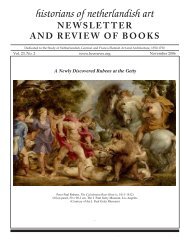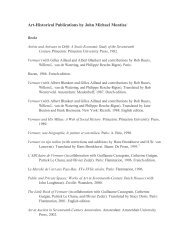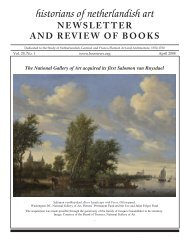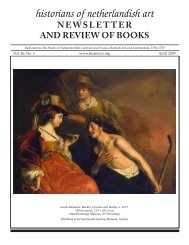newsletter - Historians of Netherlandish Art
newsletter - Historians of Netherlandish Art
newsletter - Historians of Netherlandish Art
Create successful ePaper yourself
Turn your PDF publications into a flip-book with our unique Google optimized e-Paper software.
lack and white illustrations. It is particularly nice to see<br />
included here reproductions <strong>of</strong> some <strong>of</strong> the original contracts<br />
– including one with a schematic diagram <strong>of</strong> the planned<br />
altarpiece.<br />
Lynn F. Jacobs<br />
University <strong>of</strong> Arkansas<br />
Walter S. Melion, The Meditative <strong>Art</strong>: Studies in<br />
the Northern Devotional Print 1550-1625 (Early<br />
Modern Catholicism and the Visual <strong>Art</strong>s Series, 1).<br />
Philadelphia: Saint Joseph’s University Press, 2009. I +<br />
431 pp, 157 illus. ISBN 978-0-916101-60-2.<br />
This ponderous quarto is in some respects both a summation<br />
and an extension <strong>of</strong> Walter Melion’s work <strong>of</strong> the past two<br />
decades, in which he has identifi ed and analyzed instances <strong>of</strong><br />
what he calls “meditative image-making” in <strong>Netherlandish</strong><br />
prints <strong>of</strong> the late sixteenth and early seventeenth centuries. The<br />
eight individual case studies (plus a substantive introduction<br />
and epilogue) comprised by the book have not been previously<br />
published, but Melion returns to some <strong>of</strong> his favored objects <strong>of</strong><br />
analysis, such as the plates <strong>of</strong> the Evangelicae historiae imagines<br />
(1593), mostly by the Wierix brothers after Bernardino Passeri,<br />
appended to Jerónimo Nadal’s Adnotationes et meditations in<br />
Evangelia (here the appearances <strong>of</strong> the risen Christ), and Hendrick<br />
Goltzius’s engraved series <strong>of</strong> the Life <strong>of</strong> the Virgin (1593-<br />
1594), as well as introducing other prints, print series, and<br />
book illustrations, including the plates by Boëtius à Bolswert in<br />
Antonius Sucquet’s Via vitae aeternae (1620); and several further<br />
works by Hieronymus Wierix, including two series: Iesu Christi<br />
Dei Domini Salvatoris nostri infantia (perhaps 1600-1610), and<br />
Septem Psalmi Davidici (1608; one plate is engraved by Antoon<br />
Wierix). Goltzius’s drawing <strong>of</strong> the Adoration <strong>of</strong> the Magi (1605)<br />
and Otto van Veen’s Carrying <strong>of</strong> the Cross altarpiece (c. 1610)<br />
expand the discussion into other media, but they are viewed in<br />
the context <strong>of</strong> the print tradition whence they emerged.<br />
Melion’s long-standing concern has been with artworks<br />
that can be shown to thematize their own production and function.<br />
In this volume he has selected works “that call attention<br />
to their status as images, using the theme <strong>of</strong> pictorial artifi ce to<br />
heighten the soul’s awareness <strong>of</strong> its own image-making powers”<br />
(p. 3) – powers exemplifi ed by Christ in His own fi guration<br />
as imago Dei, sanctioned by the Incarnation. The prints both<br />
represent and prompt the soul’s devotional activity.<br />
Melion adduces instances in which artists and writers commented<br />
on meditative images, such as Christopher Plantin’s<br />
prefaces to Benito Arias Montano’s Humanae salutis monumenta<br />
(1571), wherein the publisher explains the utility <strong>of</strong> the images<br />
and their relations to the texts in this novel scriptural emblem<br />
book. But he also draws attention to texts in which the language<br />
<strong>of</strong> pictorial practice is applied to meditative practice –<br />
thus Luis Granada in his Libro de la oración (English trans. 1582)<br />
says that “we must then fi gure and represente everie one <strong>of</strong><br />
these matters [concerning the Passion] in our imagination” –<br />
and in which meditation is likened to viewing a painting, as in<br />
Franciscus Costerus’s preface to his De vita et laudibus Deiparae<br />
Mariae Virginis (1588). Furthermore, Melion extracts from texts<br />
and images less explicit connections between picturing and<br />
devotion, both in production (for example, in his Protean feat <strong>of</strong><br />
imitation in the Life <strong>of</strong> the Virgin, “Goltzius tropes the imitative<br />
process, using it to convey the soul’s conversion <strong>of</strong> itself into<br />
an image <strong>of</strong> the beloved, whose likeness it craves” [p. 372]) and<br />
in viewing (we are reminded repeatedly <strong>of</strong> the role <strong>of</strong> sight in<br />
meditation; thus, for example, our viewing <strong>of</strong> the Christi Iesu<br />
vitae admirabiliumque actionum speculum, which is embedded<br />
in Montano’s Divinarum nuptiarum conventa et acta <strong>of</strong> 1573/74,<br />
doubles that <strong>of</strong> Sponsa who contemplates in a mirror images <strong>of</strong><br />
the life <strong>of</strong> Christ, her spouse, in the Acta). We are also reminded<br />
<strong>of</strong> the ways in which protagonists within compositions fi x<br />
the viewer’s relationship to the narrative; thus Saint Joseph<br />
“functions for Goltzius as a prototype <strong>of</strong> the ideal votary who<br />
meditates with his eyes, mind, and heart” and is “a type <strong>of</strong> the<br />
pious viewer” (pp. 199-200).<br />
Evoking an emblematic apparatus, the analysis typically<br />
proceeds through a juxtaposition <strong>of</strong> the selected images with<br />
textual works <strong>of</strong> devotion, some <strong>of</strong> which were already juxtaposed<br />
by their makers and others <strong>of</strong> which are Melion’s reasoned<br />
choices. Most <strong>of</strong> the texts are Jesuit; the most prominent<br />
exception is, perhaps, the Vita Christi <strong>of</strong> the fourteenth-century<br />
Carthusian Ludolph <strong>of</strong> Saxony, which was <strong>of</strong> considerable import<br />
in the sixteenth century. The images are never simply illustrations<br />
<strong>of</strong> the texts, even when that seems to be their ostensible<br />
function, as in the works appended to Nadal’s Adnotationes.<br />
Rather, one might say that they illustrate and elucidate the texts<br />
to the same extent that the texts illustrate and elucidate the images.<br />
Melion’s work is not a matter <strong>of</strong> deciphering iconography,<br />
which is in most instances not particularly obscure, but rather<br />
<strong>of</strong> discovering and explicating the rich parallels and shared<br />
tropes (shared sometimes by explicit design and sometimes<br />
through a common genealogy <strong>of</strong> practice) in the meditative<br />
programs <strong>of</strong> complementary images and texts. He <strong>of</strong>fers exceptionally<br />
close and subtle readings <strong>of</strong> both images and texts,<br />
attending carefully, as far as the images are concerned, to the<br />
formal elements that are deployed to serve the works’ function<br />
<strong>of</strong> mobilizing the viewer’s eyes, mind, and heart.<br />
The Meditative <strong>Art</strong> is an important contribution not only<br />
to our understanding <strong>of</strong> the function <strong>of</strong> images in (Jesuit)<br />
spirituality and to our understanding <strong>of</strong> the print culture <strong>of</strong><br />
the Netherlands (especially Antwerp) in the late sixteenth and<br />
early seventeenth century (whose extraordinary signifi cance to<br />
a more “mainstream” art history is still underappreciated), but<br />
also as a model for the close reading <strong>of</strong> images in conjunction<br />
with mutually illuminating texts. This volume inaugurates a<br />
series, entitled Early Modern Catholicism and the Visual <strong>Art</strong>s, by<br />
Saint Joseph’s University Press, which has in recent years published<br />
several signifi cant works in the history <strong>of</strong> art (not least <strong>of</strong><br />
which are three volumes <strong>of</strong> translations from Nadal’s Adnotationes<br />
with the relevant illustrations and substantive introductory<br />
essays by Walter Melion), each carefully produced and well<br />
illustrated. We hope that subsequent volumes in the series can<br />
match the high quality and import <strong>of</strong> Melion’s Meditative <strong>Art</strong>.<br />
James Clifton<br />
Sarah Campbell Blaffer Foundation<br />
HNA Newsletter, Vol. 27, No. 2, November 2010<br />
23







